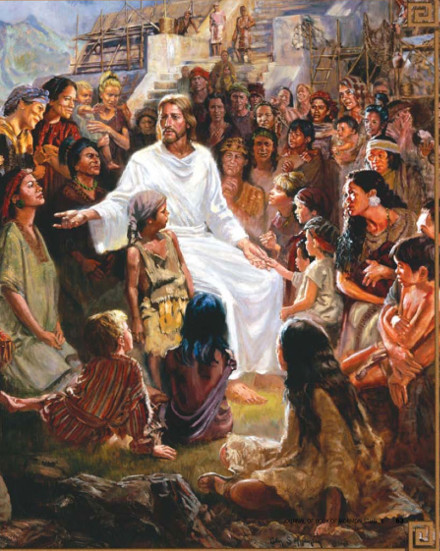
by John P. Pratt
6 Aug 2019, Summer Fast 7 REED (Toltec)
©2019 by John P. Pratt. All rights Reserved.
|
1. The Toltec Calendar 1.1 365-Day Years 1.2 52-Year Rounds 1.3 1,716-Year Ages 2. Sacred Event Dates 2.1 Age of Water (4033-2318 BC) 2.2 Age of Earth (2317-602 BC) 2.3 Age of Wind (601 BC-1115) 2.4 Age of Fire (1116-2831) 3. Conclusion Notes |
A new sacred calendar is presented based on that described in the 1610 Aztec history by Ixtlilxochitl as having been used by the earlier Toltec nation.[1] In particular, that calendar bundles years into groups of 52 years called "rounds", with those in turn grouped into four Ages (Water, Earth, Wind, and Fire), apparently designed to last for 1,716 years each. This article produces a detailed solar calendar model matching those requirements. Moreover, the unusual period of 1,716 years is explained as leading to a calendar more accurate that our modern Gregorian Calendar. Then it is shown that God is apparently using this calendar because many sacred events throughout history occur on meaningful holy days, which is what has qualified the other sacred calendars.
Those wishing to skip the details of how the Toltec Calendar was derived and how it works can skip directly to Section 2 which shows the results using Toltec holy days similar to the Hebrew and Enoch Calendar holy days. Keep in mind, however, that this calendar is very different from them, having different month and year lengths as well as a spring New Year's Day which varies by nearly a month (based on the sun) while the Hebrew Calendar varies by more than an entire month (based on the moon)!
The Aztec history gives the years of many key events throughout history, including the date of the Creation (of the two parents of mankind), of the Great Deluge, the fall of the Nahuatls (Nephites) in AD 388, and the founding and fall five centuries later of the Toltec Empire. The years are all given in terms of the 52-year Aztec round of years numbered from 1 to 13 each associated with a glyph of either Flint, Temple, Rabbit, or Reed. The history also includes a prophecy of the last Toltec king that in 520 years (10 rounds) from his death in AD 999, a new ruler would come to punish the descendants of those who had destroyed the Toltecs. That was fulfilled by Cortez, arriving in 1519. Moreover, it contains a prophecy given by another great prophet Quetzalcoatl that he would return in similar year, which turns out to be another 520 years after Cortez.
 |
Many who read that the Aztec history gives the very year of the Creation will just chuckle at the foolish creation myths of those they judge to be primitive people, not enlightened as modern man to believe in evolution, believing there was no creation. This has apparently caused many not even to continue reading the history, because it has still not been entirely published in English! But when I read the Creation date in it, two thoughts came. First, there is a date for the Beginning of Mortality given in my work, so perhaps I should read on to see if they are similar. And second, the Savior taught the Nephites many events that would occur throughout history, and surely would have taught the Toltecs similar things. So again the urge came to compare their history to mine.
The Book of Mormon records that to the early group Jesus taught:
And he did expound all things, even from the beginning until the time that he should come in his glory--yea, even all things which should come upon the face of the earth, even until the elements should melt with fervent heat, and the earth should be wrapt together as a scroll, and the heavens and the earth should pass away; -- 3 Nephi 26:3
There it explicitly states that He taught them all things from the beginning! If we do not laugh at that, perhaps we should not laugh at the Aztecs writing down what had been transmitted to them a millennium later. Their version may not be perfect, but it could contains many germs of truth worth considering. Let us proceed with that search.
The Aztecs, Mayans, Toltecs, and the earlier Nahuatls (Nephites) all used 365-day years, as did the Egyptians of 600 BC at the time Lehi left Jerusalem. Thus, the 365-year is the heart of the Toltec Calendar. As this calendar is being qualified in this article to be sacred calendar which God is using, it is important that it will be the first sacred calendar to use such years. Hebrew years are based on the lunar cycle and the Enoch, Jubilee and Star Calendars all use 364-day years because they are based on the week (7 divides evenly into 364). The planetary calendars are based on the length of their orbits as measured in units of the 13-day trecena. So while we may think it is obvious for the year to have 365 days, it is a real novelty in the realm of sacred calendars!
One question to be resolved is whether the Toltec months had 30 days each like the 30-day months of the Egyptians originally used by the Nephites[3] or whether they used 20-day months as used by the later Mayans and Aztecs. Both calendars have 360 days (either twelve 30-day months or eighteen 20-day months) followed by a final set of 5 unlucky days at the end of the 365-day year. The advantage of the 20-day months is that it allows every month to begin on a day with the same Sacred Round day sign as the first day of the year, because day signs repeat every 20 days. The advantage of 30-day months is that it allows holy days to defined as on the Hebrew and Enoch Calendars, which also have months of about 30 days. For example, Passover on the calendar given to Moses was on the 14th day of the first month (Exo. 12:2-6). Similarly, following that pattern, Passover on the Toltec Calendar would be defined to be the fourteenth day of the first month. The same is pattern is followed to define all of the Hebrew holy days on the (very different) Toltec Calendar. Some holy days fall later in the month later than the twentieth day, so this concept seems to require the use of thirty day months.
Given that definition of Toltec holy days, in order to determine whether or not God is using such a calendar, whether or not the Toltecs were aware of such holy days, computer models of 30-day months were created and printed out for all 375 dates of key historical sacred events in my Complete Religious Chronology. The result of this computer test was instantly obvious! Yes, the 30-day months with the holy days corresponding to the same days and months as the Hebrew and Enoch Calendars coincided far more often that expected by random chance. That is amazing because the Toltec calendar can vary in its starting day by about 26 days (2 trecenas) around the true spring equinox date of 20-21 March!
The twelve months of the Toltec Calendar are indicated in my work for simplicity by Roman numerals: Passover occurs on 14.I meaning the 14th day of the first month. It should also be noted that all of the Native American implementations of months begin with a "zeroth" day of each month which can be considered also the last day of the preceding month. That seems to be correct because so many sacred calendars do likewise. Thus, the days are numbered from 0 to 29 and the months are numbered I, II, III, IV, etc.[4]
Now consider another aspect of the Aztec Calendar, which was inherited from earlier tribes. One feature was that years were bundled into rounds of 52 years. Why was that? Another feature is that the year of 365 days was tied to the Sacred Round (SR) of 260 days. The tie was that a year was named after the day of the Sacred Round which fell on the first day of the first month of the year. One year began on a day 1 Flint (SR).[5] After one year of 365 days, the next year began on the day 2 Temple. The next year would begin on 3 Rabbit, the next on 4 Reed, and the next on 5 Flint. A moment's reflection shows that after 4 years, the picture comes out the same because there are 20 pictures and 4x365 = 1,460 is divisible by 20. When these names refer to year names they are capitalized in my work, so the year progression is 1 FLINT, 2 TEMPLE, etc. These four glyphs are called the "year bearers" because the years are named for them. If no leap days are inserted, then there are only 52 combinations of the four possible glyphs with 13 numbers which results in 52 possible year names. It is clear from the Aztec history that 1 FLINT is the beginning year of the cycle of the 52-year round and also of the longer 1,716-year Ages.
 |
Thus, when it comes time to insert leap days, we must wait until 13 can all be inserted as a unit. How long is that? Well, the same effect as inserting one day every four years can be achieved by inserting one trecena every 52 years. Here we see the wisdom of the 52 year cycle. When 13 days are inserted at the end, it means that the next year will begin on a day numbered 1. It will not, however, begin on one of the same four year bearer days.
Thus, as with other sacred calendars, there are two forms of this calendar, a Uniform Toltec (UT) Calendar which always was has 365 days and has all years begin on one of the four main year bearer days, but will not always start in spring. The other one, the Toltec (T) Calendar, always starts in spring and on days numbered "1" on the Sacred Round, but take turns using different sets of four glyphs as year bearers during each 52-year round. For example, the set "Flint, Temple, Rabbit, and Reed" is followed in the next 52-year round by the set "Monkey, Condor, Light, and Skull". This article focuses only on the Toltec Calendar.
It is important to know whether years names in the Toltec Calendar always use the same four year names as used by the Aztecs. Their years had no relationship to the first day because they inserted a single day when necessary, so they just used the four standard year bearer names for years. But what about the Toltec Calendar, which was more sophisticated and is a candidate to be a sacred calendar? It could have 260 unique year names if the year name were always derived by the first day of the year. For example, after the first round, after intercalating 13 days the next round begins on the day 1 Monkey so the year could be named 1 MONKEY. That would lead to a year named for each day of the Sacred Round, resulting in sets of 260 rather than only 52. That is a serious consideration because the Toltecs sometimes had celebrations after 260 years (Ixt. 3:9).
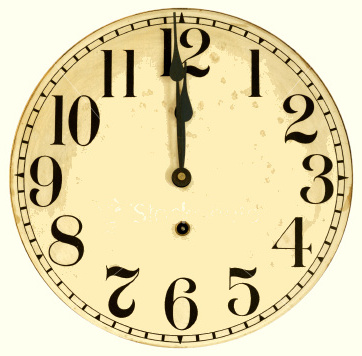 |
Some years are holy years, being the same as on the Sacred Round cycles with the same names. In particular, all years with numbers 1, 7, or 13 are holy, and those with 1 or 13 and the names TEMPLE or REED are major holy years.
There is another reason why the years are not named after the first day of each year of the round, but instead keep following the 1 FLINT, 2 REED, etc., pattern for each round. It is because the entire round, not just the year, is named for its beginning day! To understand how this works it is important to understand more about trecenas because every year begins with a trecena, which in turn is because only trecenas are intercalated.
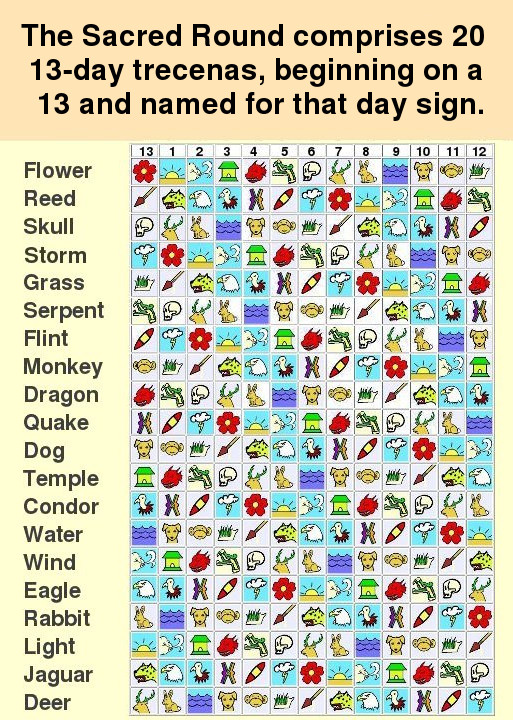 |
Second, it is important to understand that people who used this calendar, and the related Sacred Round, have memorized the order of trecenas as shown in Table 1. The twenty day signs are laid out in order going horizontally as days progress, even as the days of the trecena also progress in order. Because of this, the names of the trecenas are not in the usual order of the day signs because they are counted off in trecenas of thirteen days each. The trecena following the trecena of Light (which begins on 13 Light and is the third line from the bottom of the table) is not Wind (the day after Light) but instead it is Jaguar (beginning on 13 Jaguar) which comes 13 days after 13 Light. This may be very confusing to us,[6] but it is something that all Toltecs would have grown up knowing. It is like we know that the weekdays are Sunday, Monday, Tuesday, etc., without us having to think about the order of the 7 visible planets appearing to have been shuffled in order to get Saturn-day, Sun-day, Moon-day, etc.
Given that rounds are named for their zeroth day, it will turn out that those symbolic names are significant for that round. Examples of this will be given in the second part of the article. But here it is important to see how clever this is because it gives a unique name to each of 20 rounds. That covers a period of 1,040 years. I doubt that the Toltecs knew of this feature. In fact, it is not clear that they knew of the feature of intercalating an entire trecena at a time! The purpose of this article is to discover what version God is using, which may have been lost to later descendants, or perhaps has never been revealed at all previously (D&C 121:26-26,31).
This brings us to the unusual number of 1,716 years for the length of an Age. In the Aztec history it shows up first at the time from the Creation to the Great Deluge, which ended the first Age of Water:
The records indicate that the world was created in the year 1 FLINT, and the period of time from the creation to the flood is called Atonatiuh, which means the Age of the Sun of Water because the world was destroyed by the flood. And it is recorded in the Tulteca history that this period or first world, as they called it, lasted for 1,716 years. -- Ixt. 1:4
Here an important point needs to be made. Throughout the Aztec the author makes the attempt to attach each of four ages to having ended with a specific destruction, by earth, wind, and fire in the following ages, following the example of this first age, where the Great Deluge was indeed near the end of that age. But in the reading the about quote carefully, which he may have copied out of the early Toltec history directly, it does not say that the Flood occurred at the end, but only during an age which lasted 1,716 years. That is the interpretation in this article, that each of the ages lasted for the same period, with a length chosen for some other reason, and that each had a destruction which could have occurred at any time during that age.
Here the claim is made that the Creation occurred in the year 1 FLINT, which is important in itself. Second, it is easily noticed that 1,716 years is 33 rounds of 52 years, which would put the Great Flood near the end of the Age, with the next Age also beginning in 1 FLINT. So the question is, why 33 rounds for the length of an Age?
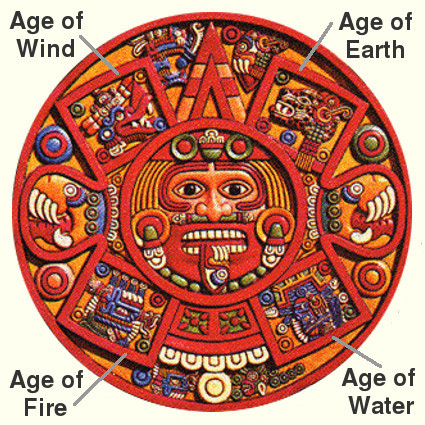 |
The answer is truly worth noting as a witness that Aztec history came from the Creator Himself! Intercalating one trecena of 13 days every 52 years yields a year of 365.2500 days, which is not accurate enough to use for 7,000 years. That was the length of the Julian year used up until the 1582, when the Aztecs pointed out to the Spanish that their calendar was off by about 10 ten days. That word got back to Pope Gregory XIII who skipped 10 days in Oct 1582 and introduced our modern Gregorian (his namesake) Calendar which skips the leap day of 29 Feb in three century years out of four resulting in an average year of 365.2425 days. The Toltec calendar needs make the same type of correction, but is only allowed to skip an entire trecena to do so. So the question is, how often should the Toltec Calendar skip one trecena to best average the true average length of the solar year?
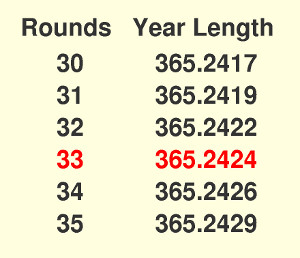 |
That result is stunning and should cause the reader to take a moment to wrap the mind around it. The Toltecs were using an Age of 33 rounds which results in the most accurate possible average year length as determined by all of our most modern methods![7] To me it means that the Aztecs did indeed preserve some valuable information from the flames that had been given to the Toltecs by Quetzalcoatl, the Plumed Serpent, Jesus Christ, which we are only now beginning to appreciate! Thus, the proposed model of the Toltec Calendar has four Ages of 1,716 years each, beginning in the year 1 FLINT in the Garden of Eden in the year 4033 BC. That year for the Creation was chosen because it coincides with the 52-year round of the Aztecs, which they presumably maintained correctly.
 |
As this calendar was analyzed it seems clear that the order is indeed as shown on the Calendar Stone. The great earthquake during the Age of Earth most likely refers to the dividing of the continents as an after effect of the Great Deluge. The Deluge was caused mostly by the opening of the "fountains of the great deep" (Gen. 7:11), which might well refer to the creation of the Mid-Altantic Ridge, which spreading has caused the two hemispheres to separate. The separation of the hemispheres might have begun rapidly and then decelerated over a century or so, corresponding to the lifetime of Peleg for up to three centuries after the Deluge (Gen. 10:25). Toward the end of his life was the Tower of Babel about 2000 BC, when the earth was also divided into nations. Even now the hemispheres continue to drift apart at a rate of a few centimeters per year, but the day will come they will be restored to being one land as before they were separated (D&C 132:23-24). Thus, it is proposed that the great earthquake of the Age of Earth referred to separation of the hemispheres.
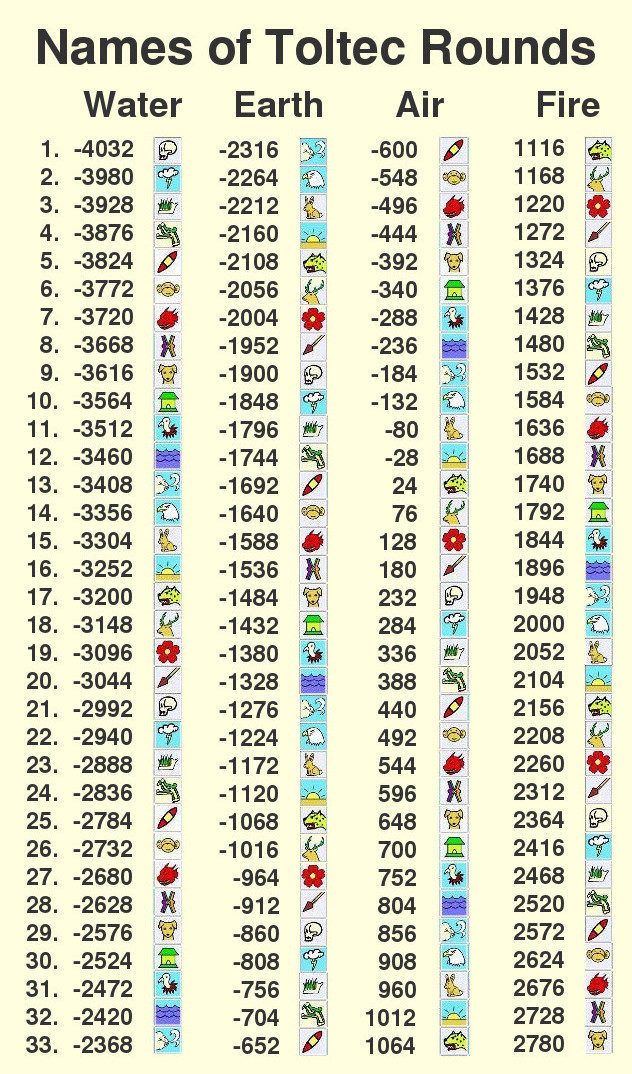 |
Table 3 shows the name of each round in each of these four ages. The age named Wind is also called "Air" in my work in order to abbreviate the name of each with one letter (W, E, A, F). Notice that the name of the first round of each age is the same as the name of the last round of the last age (D&C 29:30) because no extra trecena was intercalated after the last round. The years are given in astronomical notion of years AD: The year AS -4032 corresponds to 4033 BC.
With the Toltec model calendar determined, let us now look at how it provides yet another witness of many sacred dates of history. Minor holy days and years are shown in italics and major holy days and years in boldface italics.
Let us now look at sacred dates already proposed for events throughout history based on 16 other sacred calendars. Those dates are divided the four Ages of history as determined by the Toltec Calendar. Each Age lasts for 1,716 years, which is 33 rounds of 52 years each, with each Age beginning with the year named 1 FLINT, exactly as given in the Aztec history.
The Deluge. The first Toltec era is the Age of Water, named for the Great Deluge which ended it according to the Aztec history. So we begin with the last event of the Age because the year of the Flood proposed in my work begins in Nov 2343 BC, just 26 years before the beginning of the next Age! The Deluge begins in 1 RABBIT rather than 1 FLINT, but it is amazing that it occurred so close to the end of the Age of Water that it could indeed be considered to have ended that Age!
There is one date during that year which is not only on a holy day on the Toltec Calendar, but it is also meaningful. That makes the odds against being a random alignment significant. In that way, even one date can be compelling that it did not occur by chance. The Hebrew calendar has a holy day named "Deluge Day" in my work because it shows up in so many places and is named after the day on which the Flood began (Gen. 7:11). It is the 17th day of the 8th month on the Hebrew Calendar (PH). Thus, in assigning holy days to the Toltec Calendar, the 17th day of the eighth month was called "Deluge Day" in this article. The same procedure was followed to assign all of the Hebrew holy days to the months and days of the Toltec Calendar. It turns out that the Biblical day on which they exited the ark (Gen. 8:14-16), which until now was only holy on one sacred calendar, was on Deluge Day (17.VIII) on the Toltec Calendar. That is like a "bookend" to the Flood because it began on Deluge Day (PH). Both of those start and end days on the Jubilee Calendar (the main calendar governing the Flood) were also "bookends", both being the holy day Begin Watering (J)! All of that is beyond chance!
 |
Temptation of Eve. The day on which Eve was tempted occurred on a Decision Day (24.IV, T) just as it did on the Hebrew Calendar. The reason that is worthy of note is that the years begin at very different times varying over nearly a month.
Beginning of Mortality. This day was holy on just about every sacred calendar, being Easter (E) and also on the Toltec Calendar (21.I, T). It was also in the holy year 7 FLINT. As on all of the other sacred calendars, Easter (T) occurs on the Sunday after Passover. Even though the week was not an official part of the Toltec Calendar, it was known to them.
Let us now look at the name of the 52-year round which included the Beginning of Mortality. As explained above each round is named for one of the 20 day signs. The name of this round is SKULL, which is perfect for Mortality, because death had begun.
Birth of Seth. Adam's son Seth was born on Atonement on the Hebrew Calendar (the 10th day of the seventh month) and also on the Toltec Calendar (10.VII). It is important to notice that it is not only a holy day, but the very same holy day as on the Hebrew Calendar. As it is just one of several examples, it is far beyond chance and provides compelling evidence that God is also using this calendar.
Death of Enos. The patriarch Enos died on the same day as Adam was born on both the Hebrew (PH) and Toltec (T) Calendars. That is, as noted above, Adam was born on Tabernacles on both calendars and Enos died on that day on both calendars. That is amazing because one calendar aligns with the moon and the other with the sun. Moreover, Enos died on the day of the Scorpion's Sting (S) and on 1 Skull (SR)!
Death of Methuselah. The last patriarch to die before the Great Flood was Enoch's son Methuselah who died on Passover on the Toltec Calendar (14.I) in the holy year 1 RABBIT, the year in which the Deluge later began.
Angels to Abraham. The day on which the three angels came to Abraham to announce the birth of Isaac to Sarah was on New Year (1.I) of 1 FLINT (T), the day which began a new 52-year round. The name of that round was REED, symbolic of resurrection. Isaac would be born on the day 1 Resurrection on the Venus Calendar near the end of that very same year of 1 FLINT.
Isaac Blesses Jacob. The date proposed long ago in my work for Isaac blessing his sons Jacob and Esau was Passover on the Hebrew, Jubilee (J), and Star (S) Calendars as well as Easter (E). Now it turns out to have been Easter (T) also. Jacob also began work for Laban on Easter (E,T).
Birth of Joseph. Whereas the Toltec Calendar does not appear to have a primary use for birth dates, such as for Abraham, Isaac, or Jacob, it does turn out that Joseph was born on Easter (PH,E,T)! Moreover, his twin sons Manasseh and Ephraim were born on New Year (PH) and Consecration (10.I, T). The only other patriarch of Israel who was also born on a major holy day on the Toltec Calendar was Simeon, born on the first day of Winter (PH, T). Yet all twelve of those sons of Jacob were born on Hebrew holy days. So was it just a random alignment that those four were born on major Toltec holy days? One reason that it may indeed have been meaningful is that those are the principal tribes who migrated to the Americas: Manasseh as Native Americans, Ephraim as the English, and Simeon as the Spanish, who fathered many of today's Mexicans.
Death of Jacob. Here is another totally astounding date. The patriarch Jacob had an amazing length of life being exactly three jubilees of 49 years each, and being born on and dying on Passover (PH) and also on 1 Birth (Venus). That combination alone may have been the only such occurrence in history! Now it turns out he also died on Passover (T)! Moreover, it was in the sacred year 1 FLINT (T), which began another 52-year round, 4 rounds after the angels came to Abraham. This one was named SERPENT, representing rebirth.
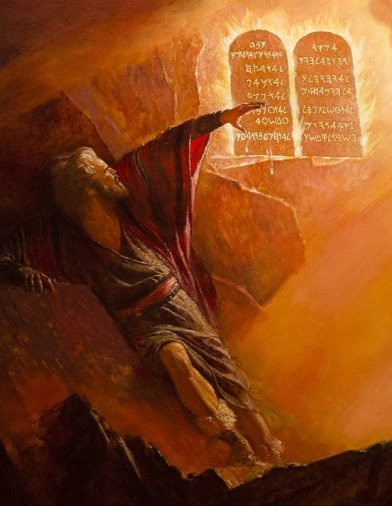 |
Crossing Jordan. The crossing of the Jordan River after the 40 years of Moses and the Israelites wandering in the wilderness was holy on multiple sacred calendars. It was End Passover (E,UE), End Transplanting (J), Passover (S), and Consecration (PH). All of those days are not just random holy days, but exactly fit different aspects of the occasion. Now it can be added that it was also Consecration (T), manifest by accepting the covenant of circumcision on that day. The name of the round including this day is TEMPLE, which represents birth, likely referring to the birth of the nation of Israel.
Fall of Jericho. The fall of the city of Jericho after Israel entered its promised land also occurred on multiple holy days, most of them being Firstfruits (PH, J, P, S), because that city represented the firstfruits of those to be conquered after the Lord bringing them to the Promised Land. Now it turns out to also have been Firstfruits (T)!
Solomon's Temple Dedication. The two-week dedication of Solomon's temple began on the Autumn Equinox (0 Aut) and ended on Tabernacles (14 Aut) on the Enoch Calendar. It also began on Atonement and ended on Great Day (J). The end date is now seen to also have been Atonement (10.VII, T).
Elijah vs. Baal. The great contest between the prophet Elijah and the prophets of Baal also occurred on Decision Days on several sacred calendars (PH, E, S). It was also Raven Day (T), which is a match because it was the day representing when Satan was released into Eden to tempt Eve. In other words, it is the Satanic part of the temptation or trial.
Lehi's Departure. The departure of Lehi from Jerusalem was just after the beginning of the year 1 FLINT not only of a round, but of a 1,040-year (20-round) age of the Nephites/Nahuatls from 601 BC to AD 440.[8] The name of the 52-year round was also FLINT. Not only that, it is the opening year of the entire 1,716-year Age of Earth. Remember that this calendar is that of the Nephites and their descendants the Toltecs. So it should be expected to be especially important for tracking events in the Americas. Such was already shown to be case as with the coming of Cortez in a year 1 REED.
Fall of Jerusalem. The fall of Jerusalem was on 1 Storm (SR) and 1 Death (V,M), which seems appropriate. Now it is seen also to have been on the first day of Summer (T). That is a major holy day, but not necessarily meaningful in representing a fall. The fall occurred in the same round named FLINT.
Ezra's Commission. Ezra the Scribe, who wrote much of the Old Testament, was commissioned on New Year (PH) and Passover (E) to return to Jerusalem after the 70-year exile to Babylon ended. That day was 1 Reed (SR). On the Toltec Calendar it was also Passover (14.I) in the year 1 REED!
Temple Rededication. The rededication of the Jewish Temple, which is commemorated by the Hebrew Feast of Dedication (Hanukkah), occurred on 1 Temple (SR) which seems very meaningful. On the Toltec Calendar it was on the holy day of the first day of the ninth month (1.IX). That does no seem to be a random coincidence because the first dedication of the temple also ended on a Toltec holy day. The name of this round was WIND, representing the Spirit.
 |
Death of John the Baptist. The length of the life of John was also amazing in how many holy days both his birth and death occurred on. To that list is now added that he was executed on End Tabernacles (21.VII, T), the very day representing death. Like the baptism of Jesus, his death occurred in the round named JAGUAR, which represents baptism and the Aaronic Priesthood.
Flesh and Blood. The Easter (PH, UH, UE) Sunday morning on which Jesus first discussed the Sacrament of the Lord's Supper by explaining that one must eat His flesh and drink his blood also occurred on Easter (T).
Crucifixion of Jesus. The Great Sacrifice of the Lamb of God occurred on the fourth day of the Toltec year (3.I), even though the day is numbered 3 because the day 0 is also part of each month. It was in the year 10 TEMPLE (T). That was not a holy day, but is worth mentioning because the Book of Mormon explicitly states that the great destruction by earthquakes at the time of the Crucifixion occurred on the fourth day of the first month (3 Nephi 8:5). It is also stated in the Aztec history that the darkening during the Crucifixion occurred "in the first few days of the year" (Ixt. 1:16). The great earthquakes at this time buried entire cities, had mountains rise where none had been and new valleys form, probably corresponds to the destruction by the earth which was supposed to occur during this Age of Earth.
Martyrdom of John Huss. The day on which the early Christian Reformer John Huss (Jan Hus) was burned at the stake was holy on several sacred calendars and is still celebrated in the Czech Republic as a sacred day. On the Toltec Calendar it was in the holy year 1 REED.
Discovery of America. Christopher Columbus discovered the New World in the holy year 13 FLINT (T). That seems important because this calendar seems especially important for events in the Western Hemisphere. Moreover, it occurred in the round named SERPENT, which represents rebirth. This discover was indeed like a rebirth. This was also the round in which Cortez came in the year 1 REED.
U.S. Constitution Ratified. The Constitution was approved on Mon 17 Sep 1787 which was not a significant holy day on any sacred calendar until now. The date has been in my database of sacred events anyway because of its importance. Now it turns out to have been the Feast of Trumpets (T), when important announcements of the kingdom are heralded by the sounding of trumpets!
Birth of U.S. In my work, the official birth date of the U.S., when everything began to function as when a child is born, was Mon 6 Apr 1789, when the George Washington began as President and Congress was fully functioning. On the Hebrew Calendar that day is counted from the preceding evening and that was when many sacred calendars aligned. That time was also Easter Sunday (T).
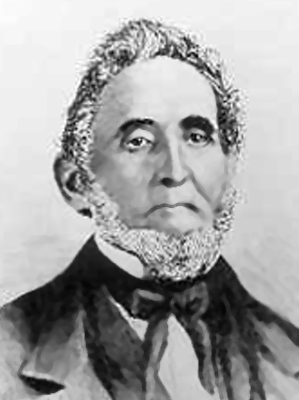 |
The 52-year round which began in the year of Sidney's birth would encompass the entire restoration of the Church of Christ, up through the death of of the martyrs Joseph and Hyrum Smith. The name of this round was TEMPLE, symbolizing birth. That era was truly the birth of the restoration of the fulness of the Gospel in thise latter days.
Birth of Joseph Smith. The birth of the Prophet Joseph Smith occurred in the year 1 TEMPLE (T), the major holy year which especially represents birth. His wife Emma had been born during the previous holy year 13 FLINT (T).
First Vision. The date of the First Vision of the Prophet Joseph Smith on Sun 26 Mar 1820 was on New Year in a year NEW YEAR (E). In fact, that day began an entire 728-year "week" in the Prophecy of Weeks in the Book of Enoch. It also was on Passover (S) and the Seer (US). Now it turns out that it was also on New Year (T)!
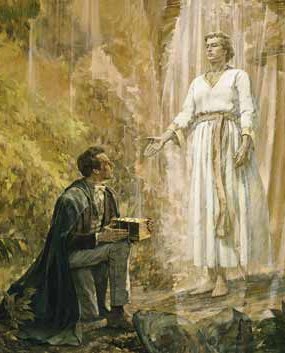 |
Lost Manuscript. It has been pointed out in my earlier articles that the day on which the Prophet Joseph chose to allow his scribe to take home the 116 pages of the translation of the first part of the Book of Mormon was a Decision Day, as well as the day on which the scribe confessed to having lost them, and then later the day on which the Lord chastised Joseph severely for his folly. The Hebrew, Enoch, and Toltec calendars each have three Decision Days a week apart in the summer. It turns out the last two of those three days were also Decision Days (T).
 |
Zion Founded. The founding of the land of Zion in Missouri, preparatory to building the City of Zion, occurred in the year 1 REED (T), which seems significant. The Aztec history lists several cities which were founded in a year numbered 1. This becomes especially interesting because Moses also led Israel to a Promised Land in a round named TEMPLE, and Joseph was "like unto Moses".
Easter Conference. The important Church general conference held in the land of Zion in 1833 occurred on Easter Sunday (PH, E). It was also Easter (T).
Martyrdom of Joseph and Hyrum. The murder of the Prophet Joseph and Patriarch Hyrum Smith occurred in the year 1 FLINT (T). That is the year which starts a new round, and truly that occurred. It happened in the Prophet's 39th year (1 REED to 1 FLINT) and it completed the round of 52-year round begun with the birth of Sidney Rigdon, who was the surviving counselor in the Presidency of the high priests who presided. Instead of his being chosen to continue leading the Church as he proposed, the apostle Brigham Young instead later became the new president, which indeed began a new era of Church history. Table 4 shows the remarkable ties of the early history of the Church to one Toltec round.
Destruction of Wicked. The current Age of Fire also will include the burning of the proud and wicked by fire (Mal. 4:1), for which the Age is named. That happens at the end of the coming reign of the Antichrist and just before the Second Coming of Jesus Christ.
To conclude on a happier note, the name of this current 52-year round which began in the year 2000, is EAGLE, representing the Melchizedek Priesthood and being given the wings to soar like an eagle with the acute vision of a seer. Thus, the name seems to be focused on the founding of the city of Zion, the return of Enoch's city, and the glorious Second Coming of Christ during this round.
A model for a Toltec Calendar is proposed based on the description given by the Aztec history compiled by Ixtlilxochitl in 1610. It has 365-day years bundled in rounds of 52 years. Intercalation is done by inserting one 13-day trecena at the end of each round, and then skipping one trecena after 33 rounds (1,716 years), which is the "Age" unit of time mentioned in that history. That scheme results in an average year of 365.2424 days, being more accurate that our Gregorian year of 365.2425 days. Following the pattern of the ancient Egyptian Calendar, the calendar uses 30-day months rather than the usual 20-day month of the Aztec and Mayan calendars, allowing Hebrew holy days to be defined.
That calendar is then used to calculate Toltec dates of all the sacred events throughout history used in my work. It was found that a much higher number of events fell on meaningful Toltec holy days and in holy years than could possibly be expected by chance, indicating the this calendar qualifies as a sacred calendar being used by the Creator!